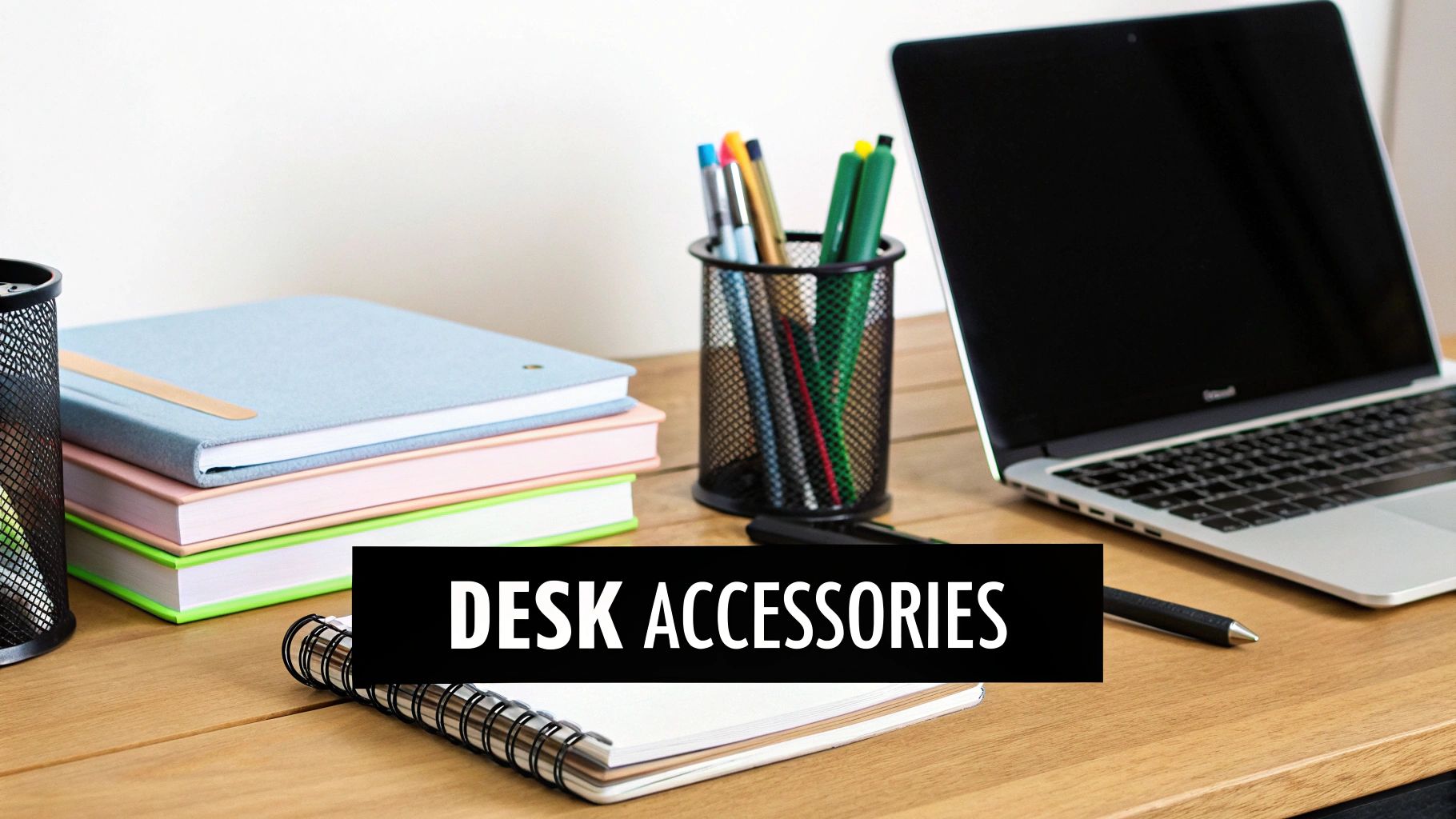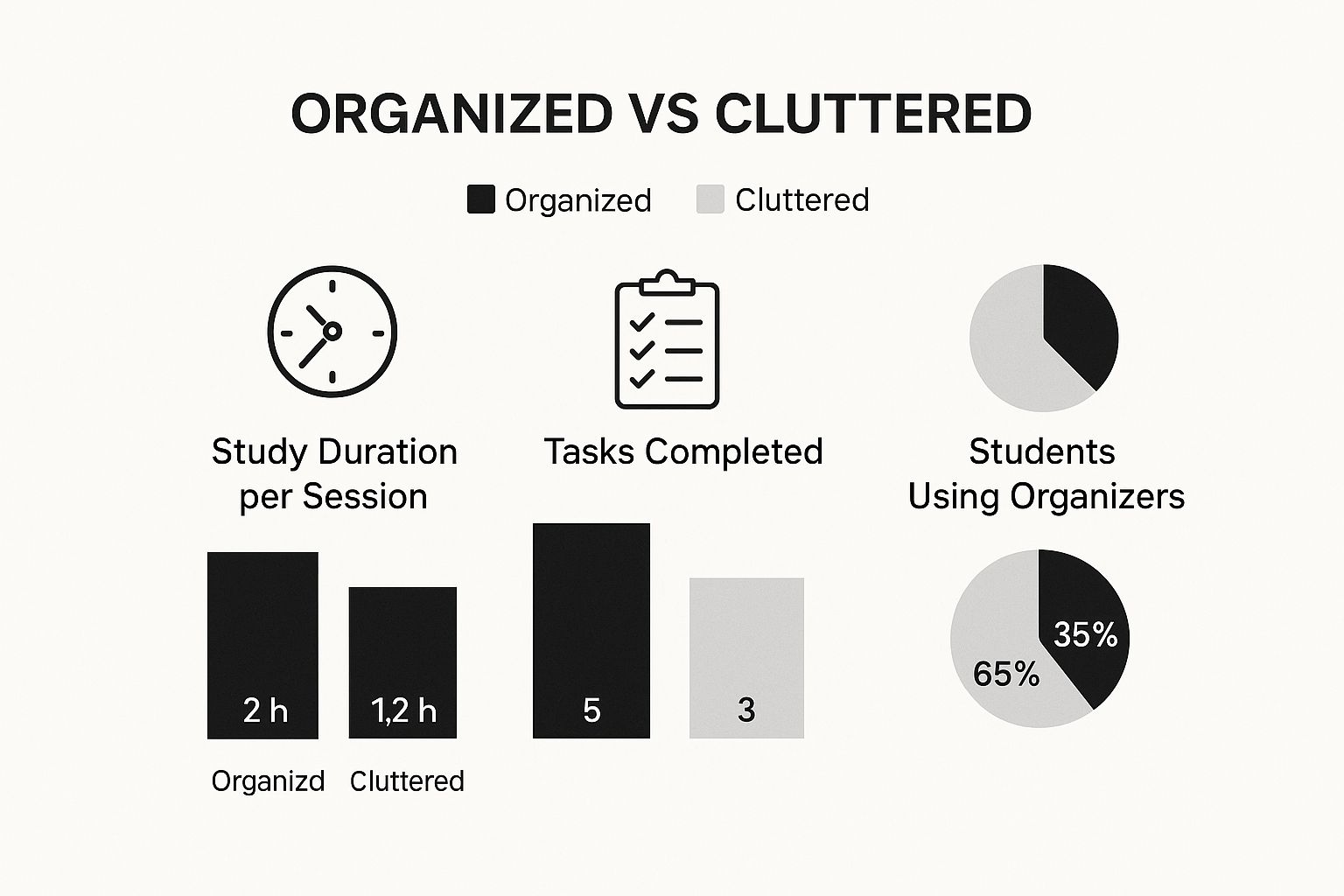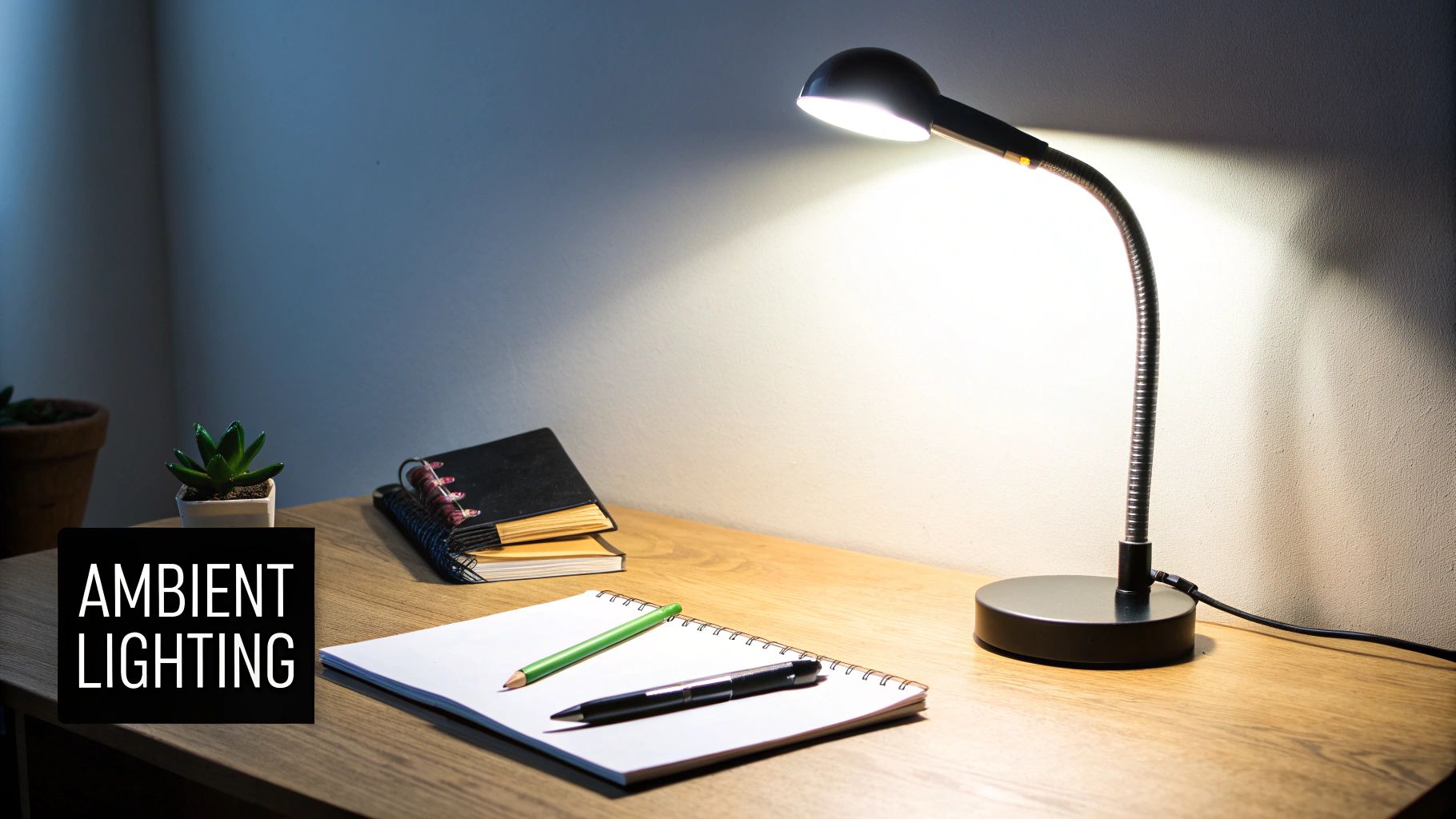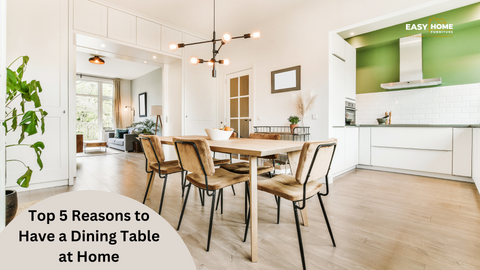Think of a great study desk as more than just a piece of furniture. It's the central hub for a student's entire academic world—the command centre where focus is honed, materials stay organised, and a productive mindset is built. Honestly, choosing the right one can completely transform how a student approaches their work.
Why Your Study Desk Is Your Most Important Learning Tool

I always tell parents to view a study desk as the very foundation of their child's learning. It's a bit like a chef's kitchen; you can’t expect a culinary masterpiece from a chaotic, poorly equipped space. When a student tries to work at the dining table or sinks into the sofa with a laptop, they're battling constant distractions that shatter concentration and make real learning a struggle.
A dedicated desk creates a powerful psychological cue. It silently says, "this is where we focus." This simple mental shift helps students switch into 'study mode' and leave the world of entertainment and relaxation behind. That dedicated zone is absolutely essential for building the kind of consistent study habits that pay off in the long run.
The Foundation of Focus and Health
The right desk does so much more than just hold a laptop and a few textbooks; it has a direct impact on physical wellbeing. A desk that’s too high, too low, or just poorly designed leads to slouching, neck pain, and a general feeling of discomfort. That kind of physical distraction can easily derail even the most determined student.
When you get the desk right, it naturally encourages better posture. Good posture means better energy and concentration, especially during those long study sessions before an exam.
With home study and remote learning now a normal part of life, more families are seeing the wisdom in investing in proper study furniture. This isn't just an observation; the numbers back it up. In Australia, the home office furniture market—which covers desks and chairs—was valued at around US$581.92 million in 2025 and is projected to keep growing. This trend clearly shows that people are serious about creating effective and comfortable learning spaces at home. You can dig into more data on the Australian home furniture market on Statista.
By prioritising ergonomics and organisation, a good study desk becomes an active partner in the learning process, not just a passive piece of furniture. It is the single most important tool for fostering a productive and healthy academic journey.
Finding the Right Desk Type for Your Space and Needs

Choosing the right study desk for students is a bit like picking the perfect pair of shoes—what works wonders for one person might be a terrible fit for another. The best choice really comes down to the student's unique study habits and, of course, the room they'll be working in. Getting this right from the start lays the foundation for better organisation, comfort, and focus.
The classic writing desk is a timeless choice for good reason. It’s simple, straightforward, and offers a generous flat surface perfect for spreading out textbooks, a laptop, and notepads. Their clean design means they can blend into almost any room style, but they often lack modern conveniences like built-in cable management, which can be a real headache if you're juggling multiple devices.
If tech is a big part of the study routine, a dedicated computer desk is usually a smarter move. These are built for the digital age, often coming with handy features like keyboard trays, holes for routing cables (grommets), and even shelves for a monitor. This design helps keep the workspace tidy and free of tangled wires, which is key to minimising distractions.
Maximising Your Space and Workflow
Let's be honest, space is usually the biggest challenge in a student's room. If you're dealing with a compact or oddly shaped area, a corner desk can be a brilliant problem-solver. They tuck neatly into a corner, transforming what is often wasted space into a productive zone. The L-shaped surface is also a huge plus, giving you two distinct areas—one for the computer and another for writing or reading.
For the ultimate space-saving solution, a floating or wall-mounted desk is hard to beat. By fixing directly to the wall, they create a sleek, modern aesthetic and free up the floor entirely. This can make a small room feel much bigger and is an ideal choice for multi-purpose spaces where every square centimetre counts.
Think of your desk not just as furniture, but as the control centre for learning. The goal is to match its form and function to the student's specific workflow, whether that involves digital design, writing essays, or solving complex maths problems.
The Dynamic Choice: Standing Adjustable Desks
One option that has become incredibly popular lately is the standing adjustable desk. These are a real game-changer, allowing students to switch between sitting and standing with a simple button press or manual lift. We all know that sitting for hours on end leads to fatigue and aches, and being able to move around can make a massive difference to energy levels and concentration.
An adjustable desk helps create what I like to call "active studying." By regularly changing posture, students can fight off the physical strain that so often leads to a restless, wandering mind. This makes the adjustable desk a powerful tool for staying physically comfortable and mentally sharp, turning a long study session into a far more dynamic and productive experience.
The Rise of the Adjustable Standing Desk for Students
Standing desks aren't just for trendy corporate offices anymore. They've found a new, and arguably more important, home in student study spaces. This isn't just a fleeting trend; it's a smart response to what we now know about how our physical state affects learning, especially during those long, demanding study periods.
The concept is beautifully simple. Giving a student the choice to stand up or sit down while they work introduces gentle, natural movement into their routine. It's a game-changer for fighting off the fatigue, sore backs, and general restlessness that inevitably creep in after hours in a chair. It keeps the body engaged, which in turn helps the mind stay sharp.
This dynamic approach can work wonders for concentration. When focus starts to fade, simply standing up can be like hitting a reset button. It gets the blood flowing and gives a little energy boost, making it that much easier to power through a tricky problem set or a marathon revision session.
Why Dynamic Studying Matters
An adjustable desk encourages what you could call "active studying". It’s the direct opposite of being stuck in one spot, where physical discomfort quickly becomes a mental distraction. Think of it as a secret weapon against that drowsy, unfocused feeling that hits mid-afternoon.
By making it easy to change posture, these desks help students stay more engaged and less susceptible to the physical strain that can completely derail a productive study block.
The image below highlights just how much an organised desk can influence study habits. A spacious, adjustable desk often makes it much easier to keep things tidy and efficient.

As you can see, a well-organised study area isn't just about looking neat—it directly contributes to longer, more effective study sessions and getting more done.
Sit vs Stand Desk Comparison for Students
Deciding between a classic sitting desk and a modern standing desk can be tough. Each has its place, but they offer very different experiences for a student. This table breaks down the key differences to help you see which might be the better fit.
| Feature | Traditional Sitting Desk | Adjustable Standing Desk |
|---|---|---|
| Ergonomics | Static posture, can lead to strain if not set up perfectly. | Dynamic posture, promotes movement, reduces sedentary risks. |
| Focus & Energy | Can contribute to fatigue and drowsiness over long periods. | Standing can boost energy and reset focus when concentration wanes. |
| Cost | Generally more budget-friendly and widely available. | Higher initial investment, but prices are becoming more competitive. |
| Space & Stability | Often compact and very stable by design. | Can require more floor space; stability at maximum height is a key consideration. |
| Best For | Shorter study sessions or students on a tight budget. | Long study marathons, students prone to restlessness, or those focused on health. |
Ultimately, while a traditional desk is a reliable and affordable option, an adjustable standing desk offers significant benefits for health and concentration, making it a powerful tool for serious students.
Key Features to Look For
Not all adjustable desks are created equal. If you're considering one, here are a few critical features that separate a good desk from a great one.
- Manual vs. Electric Lift: Manual desks use a hand crank to change height. They're cheaper but require a bit of elbow grease. Electric models adjust with a button press, offering effortless and smooth transitions.
- Memory Presets: This is a fantastic feature on many electric desks. It lets a student save their ideal sitting and standing heights, so switching between them is instant—no fiddling around to find that perfect spot again.
- Size and Stability: Make sure the desktop is big enough to hold a laptop, textbooks, and notebooks without feeling cluttered. Crucially, check that it's sturdy and doesn't wobble when raised to its full height.
The growing demand for ergonomic and flexible furniture is a clear trend. The Australian office furniture market, which includes study desks, is valued at approximately USD 1.17 billion in 2025 and is projected to keep growing. This shift shows how much we've come to value designs that support how we actually work and study today. You can learn more about these Australian market trends if you're interested in the data.
Choosing an adjustable standing desk is really an investment in a healthier, more productive learning environment. It gives students the power to manage their own physical comfort, which directly helps them stay focused and nail their academic goals.
Mastering Ergonomics for a Comfortable Study Setup

So, you’ve found the perfect study desk for students. That's a great start, but it's only half the battle. If the setup is uncomfortable, it won't be long before neck strain, backaches, and a fidgety mind take over. Even the best desk can become a place of frustration.
The secret to creating a study station that supports hours of focused work is understanding a few simple ergonomic principles. Think of it as custom-fitting the study space to your child, rather than forcing them to awkwardly fit into the space. The goal is a neutral, relaxed posture where physical stress melts away, paving the way for better concentration.
The 90-Degree Rule for Perfect Posture
The cornerstone of any comfortable setup is getting the angles right. It’s a simple but incredibly effective guideline for establishing a healthy posture.
- Elbows at 90 Degrees: Adjust the chair height so their arms form a neat 90-degree angle when their hands rest on the desk. This means their shoulders can stay relaxed and down, not hunched up around their ears.
- Knees at 90 Degrees: With their feet flat on the floor, their knees should also be bent at a 90-degree angle. If their feet are dangling, a small footrest is an easy and brilliant fix.
This simple alignment is the key to preventing strain on the wrists, shoulders, and lower back. Of course, a great chair is a huge part of this equation. A quality mesh ergonomic office student chair with lumbar support can make all the difference in supporting this ideal posture.
Positioning Screens and Materials
Once the body is correctly aligned, it’s time to arrange their work materials. Remember, where the eyes go, the neck is sure to follow. Getting screen placement right is absolutely vital for avoiding that all-too-common neck and shoulder pain. The top of the monitor or laptop screen should be positioned at or just slightly below their eye level.
An easy way to achieve this is to stack a few textbooks under a laptop until it reaches the right height. This simple hack ensures the student's head stays in a neutral position, preventing the forward head posture that causes so much strain.
This principle doesn’t just apply to sitting. For those using standing desks, the same rules apply. Whether sitting or standing, the relationship between the hands, body, and screen should always stay the same to maintain those perfect ergonomic angles.
Choosing Smart Materials and Storage Solutions
A great study desk is much more than just a flat surface. It needs to be tough enough to handle daily life and smart enough to keep everything organised. The materials and storage you pick will play a huge part in how long the desk lasts and how clear that study space stays.
Think of the desk’s material as its fundamental character. A solid wood desk, for example, is the classic, long-lasting option. It’s built like a tank and can genuinely last for generations. While it might cost more upfront, its sheer durability often makes it a smart investment for a piece of furniture that will see years of intense use.
On the other end of the spectrum, you have materials like Medium-Density Fibreboard (MDF), a really popular and budget-friendly choice. MDF gives you a smooth, stable surface and comes in a massive range of finishes. It's not as tough as solid wood, of course, but a well-constructed MDF desk with a quality laminate can easily handle the demands of student life.
Finding the Right Balance of Durability and Function
The material you choose sets the tone for the desk's look, feel, and, importantly, its price. Here’s a quick look at some common options you’ll come across:
- Metal: Desks with metal frames are fantastic for their strength and modern, industrial vibe. They're usually paired with a wood or glass top and offer excellent stability.
- Glass: A tempered glass top can really open up a room and make it feel lighter and more spacious. It’s a stylish choice, but be prepared for regular cleaning to keep it fingerprint-free. It might not be the best pick for younger, more boisterous kids.
People are definitely looking for quality furniture that lasts. In Australia, the furniture market, which includes essentials like the humble study desk, is valued at a whopping USD 2.98 billion in 2024 and is expected to keep growing. It shows that families are increasingly willing to invest in pieces that are both functional and built to last. You can read more about the Australian furniture market forecast on expertmarketresearch.com.
The best material is simply the one that fits your budget, works with your home's style, and can stand up to your student's daily routine. No matter what material you choose, don't ever overlook the importance of a solid, sturdy build.
Smart Storage for a Clutter-Free Mind
Once you’ve got the material sorted, it's time to think about storage. This is a big one. A cluttered desk almost always leads to a distracted mind. The secret is integrated storage that keeps all the essentials nearby but neatly tucked away.
Desks with built-in drawers are a lifesaver for hiding away stationery, calculators, and all those little bits and pieces that create chaos. If you need more room, a desk with a hutch is a great way to use vertical space for textbooks, folders, and even a few personal items.
It can also pay to think about storage in the whole room. For instance, creative solutions like the Alicia Storage Bed can free up valuable space, meaning you might not need a bulky, separate bookshelf.
The real aim here is to match the storage to what your student actually needs—whether it’s for art supplies, a gaming setup, or piles of textbooks. A well-organised desk isn't just about being tidy; it's a launchpad for focused, productive work.
Building Your Perfect Study Zone
We've covered a lot of ground, from ergonomics to the nitty-gritty of materials. Now it's time to pull all those threads together. Creating the perfect study zone isn't about finding one magical "best" desk; it's about crafting a space that genuinely helps a student thrive. This means making thoughtful choices that foster health, focus, and organisation for years to come.
The whole process starts with a simple, powerful action plan. By focusing on a few key areas, you can confidently invest in a study desk for students that’s so much more than just a piece of furniture. It becomes the very foundation of a productive and inspiring school life.
Your Action Plan for Success
First things first: make ergonomics your top priority. A comfortable student is a focused student, period. Making sure the desk and chair work together to support a healthy posture isn't just a bonus—it's crucial for preventing the aches and pains that can completely derail a long study session.
Next up, give some serious thought to an adjustable standing desk. The simple act of switching between sitting and standing is a total game-changer for keeping energy levels high and a student's mind engaged. It encourages natural movement, battles fatigue, and creates a more dynamic environment to tackle tough assignments.
A study desk should be a launchpad for success, not an obstacle. Investing in a setup that promotes physical wellbeing and mental clarity is one of the most impactful decisions you can make for a student's academic journey.
Finally, choose materials that are built to last and fit your budget. A solid frame and a tough surface ensure your investment can handle everything from late-night revision sessions to sprawling creative projects. And don't forget storage! A tidy desk really does support a clear mind.
The ultimate goal is to build a study zone that works for the student. It needs to be a space they feel good in, a place that cuts down on distractions and helps them reach their potential. Think beyond the desk itself and consider how to create a functional space for the entire room. For instance, a clever Boston Storage King Bed Frame can free up valuable floor space, making the whole room feel larger and more organised.
By following these steps, you're all set to create a study zone that will support their learning goals for years to come.
Your Top Questions About Student Desks, Answered
Picking out the right student desk can feel surprisingly tricky, and it's totally normal to have a few questions floating around. To help you make a choice you’ll be happy with, we’ve put together some straight-to-the-point answers to the queries we hear most often.
What’s the Best Desk Size for a Student's Room?
The perfect desk size really hinges on two things: how much study gear the student has and the actual size of the room. A great all-rounder and a solid starting point for a study desk for students is a surface that's at least 120cm wide and 60cm deep. This gives you enough real estate for a laptop, an open textbook, and a lamp without everything feeling on top of each other.
Of course, always get the measuring tape out before you buy anything. You need to account for the space itself, but also leave enough room to pull the chair out without bumping into the bed or the wall. If you're working with a tight space or a tricky corner, a more compact desk around 90-100cm wide or a purpose-built corner desk can be a brilliant, space-saving fix.
Are Standing Adjustable Desks Actually Worth It for Students?
For students who are logging serious hours at their desk, the answer is a big yes. The real magic of an adjustable standing desk is that it encourages you to move. It’s a simple but effective way to fight off the fatigue, sore backs, and general grogginess that can set in after hours of sitting.
Being able to easily switch from sitting to standing is a game-changer for staying comfortable and focused during long study sessions.
While the upfront cost is a bit higher than a standard desk, think of it as an investment. The long-term health benefits and the boost in productivity can make it incredibly worthwhile, especially for senior high school or uni students facing heavy workloads.
How Can I Find a Good Study Desk on a Budget?
You absolutely don't have to spend a fortune to get a great desk. It's all about shopping smart. Keep an eye out for seasonal sales and don't be afraid to check out secondhand options on local online marketplaces—you can find some real gems.
When you're buying new on a budget, zero in on the things that matter most: a solid frame and a smooth, hard-wearing work surface. You'll often find that desks made from high-quality MDF or those with a sturdy metal frame offer the best bang for your buck. Remember, a simple, well-built desk is a perfect foundation. You can always add affordable, separate storage units down the track as you need them.
Ready to find a desk that ticks all the boxes for style, function, and budget? Explore the wide range of study solutions at DLB Furniture, where quality and affordability come together. Visit us at https://dlbfurniture.com.au to find the perfect fit for your study zone.










